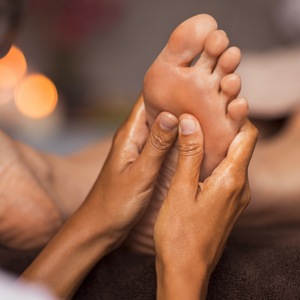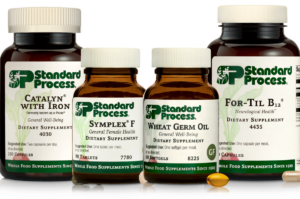By Claire Bacon, ACN, CNC
Playing competitive sports can be one of the most exhilarating and rewarding experiences in a young woman’s life. The teamwork, friendships, and skills involved can take an otherwise awkward teenager and make her into a confident, high-achieving woman. Exercise and the dedication that goes with it can build her physique, self-esteem, and character. But what happens when exercise goes too far? What happens when an athlete becomes “elite” and sacrifices certain aspects of “normal” life to become the best?
The female athlete triad is a syndrome that commonly affects competitive female athletes. Three interrelated conditions commonly develop when a girl or young woman goes to extremes in dieting or exercise. The triad may manifest differently between individuals, but generally includes the following 3 characteristics:
- Low energy availability caused by not balancing the calories burned during exercise with calories consumed. Eating disorders may play a role.
- Amenorrhea (loss of menstrual periods or delay of first menstrual period) caused by low hormonal output and lack of raw materials (fat and cholesterol) to create hormones.
- Low bone mineral density and frequent stress fractures due to malnutrition or malabsorption, and catabolic processes burning through tissue reserves.

Low Energy and Lackluster Performance
Females who participate in sports where being thin is valued (gymnastics, dance, cheer, or skating), or where performance generally improves as weight comes down, (sprinting, track and field, distance running, or rowing) are at a higher risk for the triad. Even worse, parents and/or coaches may apply additional pressure to eat less or cut down on weight as they push athletes to be their best.
Being conscious of a healthy diet is one thing, but developing an eating disorder is quite another. Many females may not realize their preoccupation with body shape and weight. They may develop poor nutritional habits in an effort to keep fat content and calories low.
Meanwhile, demanding practices continue. High-intensity workouts and two-a-days are taxing to the body and the hormonal system. Exercise can exacerbate high cortisol (the body’s stress hormone), which becomes catabolic when your cortisol is too high for too long. What that means is your body starts consuming nutrients stored in your muscle mass, if you’re not consuming the right nutrients to fuel growth, repair, and recovery.
Think about it – if every day you’re running from a tiger, that becomes priority #1. You must escape the tiger. So, the body will prioritize cortisol production over your other sex hormones, and will steal nutrients from wherever they are stored in order to run the engine. Muscles (especially glutes) store valuable nutrients. So, if you push too hard for too long, you may find your powerful muscles disappearing, too.
As time goes on, your weight might hit the desired mark, but your PR’s might be a thing of the past. If you find yourself not able to get out of bed, not able to socialize after practice, or dropping lean muscle mass, it’s time to reconsider your nutrition and training strategies.

Amenorrhea
As mentioned previously, when cortisol is high, it’s usually at the expense of other hormones, like estrogen, progesterone, and testosterone. Your body can only do so much. It makes hormones from your collective “pot” of cholesterol. Cortisol, DHEA, and sex hormones all come from the same place. It’s like a teeter-totter. If Cortisol goes high and stays high long enough, estrogen, progesterone, and testosterone will eventually suffer.
Having a very low percentage of body fat (below 16 percent) can lead to irregular menses or stop menstrual periods altogether (amenorrhea). The menstrual cycle is very delicate. The whole process depends on a quality estrogen surge from the ovaries. If the estrogen surge is strong enough, that signals the pituitary to release FSH (follicle stimulating hormone) followed immediately by LH (luteinizing hormone). The purpose of these two is to stimulate the growth and release of the strongest egg each month. Once the follicle releases the egg, it begins producing progesterone, which is the perfect calming and maturing hormone that balances out the proliferative effect of estrogen.

When the cycle is confused…
That’s how the reproductive system is supposed to work. However, with too high cortisol, estrogen levels will drop. The result is that estrogen will not peak as high and the pituitary won’t get a clear signal. And then FSH and LH may not release on time, so the ovaries don’t get the clue it’s time to release the egg. And without ovulation, you’re not going to get any progesterone. So, the whole system becomes confused. The uterus won’t know when to bleed, and even if it wanted to, the endometrial lining hasn’t been exposed to enough estrogen to thicken or enough progesterone to mature.
If that’s not bad enough, having disrupted hormones like this can also contribute to anxiety, depression, and mental illness. You can see why we need to protect our hormones!

Low Bone Density/Stress Fractures
The triad can cause low bone density and osteoporosis. Osteoporosis in teenagers is associated with a significant fracture history, especially if the injury that caused the break is a low-impact injury. Obviously, stress fractures at a young age is not normal. Your spidey-senses show go up and tell you something is wrong! Osteoporosis is becoming increasingly recognized in young female athletes.
When calories burned during exercise are not balanced by a sufficient intake of calories, estrogen production will decrease. Estrogen is very important for optimal bone health. We talk about this all the time in the context of menopause but it’s particularly important in a teenager because bones are still forming. Having low estrogen disrupts the body’s bone-building processes and weakens the skeleton, making bones more likely to break under an intense training schedule – or even a simple misstep in daily life.
Frequent sites of injury include:
- the tibia,
- femur,
- wrists,
- forearm,
- metatarsals, and
- pelvic bone.

How to Turn the Female Triad Around
With so many negative consequences, it really makes you wonder if all the training and hard work is worth it? Well, only for a second. Any competitive athlete who lets that thought in her mind will immediately say, “Yes! It’s worth it!” Because this is where we find our identity, our purpose, and our social fabric. If you love your sport and all you think about is how to be better, how to win, etc., you won’t hesitate for a second whether the training is worth it. It is.
So, let’s think about ways we can reduce the risk of developing the female triad. Can we train and compete at a top level without impacting our hormones? How can we have our cake and eat it, too?
1. Eating a nutrient-dense diet
If you want your body to perform, you’ve got to FUEL it appropriately. Your body needs REAL FOOD, not gluten-free pretzels or zero-calorie soft drinks. Think about the building blocks you’re trying to repair in your muscles. You need protein! And to support your hormones? You need fats! Think high-quality chicken, turkey, beef, fish, seafood, eggs, nuts and seeds. Olive oil, butter, avocado, and coconut oil. And if you’re going to have carbs? You want quinoa, lentils, squash, and sweet potatoes.
These are the most powerful foods to rejuvenate your muscles when you’re pushing to your limits.

2. Resting when you need it
When do you think the magic happens? Clue: It’s not when you’re running! It’s in the deep stages of sleep when your growth hormone is released. That’s when the process of recovery happens – throughout your body, and in your brain, too.
The release of human growth hormone (or HGH) lays the foundation for healing and muscle recovery. This rest period allows our cells to mend, tissues to renew, and organs to recuperate, effectively allowing the body to recover from injuries. Sleep deprivation interferes with this crucial process, potentially prolonging the recovery period. This makes it take longer for the body to repair damaged tissues and muscles.
So, don’t skimp on your sleep. It’s a key part of being able to work out the next day!

3. Weight training
What’s a great way to prevent stress fractures? Build more muscle mass! That’s right, greater muscle mass can disperse impact forces that are transmitted to the bone.
Strength training puts stress on bones and can nudge bone-forming cells into action. This is so important when we’re young! The applied stress from tugging and pushing on bones during strength training results in stronger, denser bones.
And strength training targets bones of the hips, spine, and wrists, which are the locations most likely to fracture. What’s more, resistance workouts (with dumbbells, not machines) enhance strength and stability, too. We want you to progressively use heavier weights. Don’t stay with the same 15 lb weights forever!
No one reaches the peak of athletic success just doing cardio all the time. If you want better tone, better power, better speed, you’ve got to hit the gym!

4. Musculoskeletal and soft tissue support
You should know by know that we are big fans of Chiropractic! Of course we’re a little biased, as we have the best Chiropractors in East Cobb right here in our office. We’re very proud of Dr. Bob’s Total Body Assessment, which goes through every joint – including extremities. Getting adjusted is the best way to stay ahead of injury! All of us get adjusted once a week for our own optimal performance. (Maybe more if working on something specific).
And of course, don’t forget the power of regular massage therapy. It’s not a luxury – it’s actually required if you want to perform your best. Heavy training causes so much discomfort: microtears, stretched muscles, swollen and tight joints… and if you’re a bit dehydrated that can lead to sticky adhesions, too. Don’t feel guilty about scheduling massages both before and after competition. A good massage therapist (like Karen upstairs!) will work out the kinks and recommend some therapeutic stretches you can do on your own, in between sessions.

5. Targeted supplements
There are a million supplements out there, and it takes a good bit of education and discernment to choose something that will actually help. Here are our best choices to get started…

- Catalyn with Iron – a true whole-food multivitamin, with a little bit of all the good nutrition you’re just not eating. Contains a good dose of iron, which is commonly depleted in competitive female athletes.
- Symplex F – our foundational glandular extract blend for the female endocrine system. Contains extracts from adrenals, thyroid, pituitary, and ovaries to encourage normal signaling, growth, and repair.
- Wheat Germ Oil – contains cold-pressed oil from the wheat germ. Interestingly, this is a gluten-free product. Contains vitamin E, and so is supportive of the ovaries, and oxygenating to the muscles. Helps reduce muscle fatigue with extended exercise.
- For-Til B12 – this is one of our favorite mineral blends to support female hormones, because it contains sex hormone precursors sourced from Spanish Moss. Combined with vitamin B12 to support neurological health.
Of course, we would also recommend an amino acid blend like Perfect Amino, Omega 3s from a high quality fish oil, and a probiotic blend to maintain good gut health. And let’s not forget – Cardio-Plus is amazing to help you breathe more easily with intense aerobic exercise!
To Sum Up…
Key takeaways for the female athletes out there…
- Eat a well-balanced, nutrient-dense diet with enough calories so you’re never in a deficit
- Rest when you need it
- Weight training – and push it with heavy weights!
- Musculoskeletal and soft tissue support: massage, chiropractic, stretching
- Using targeted supplements.
That’s all for today. Time to get out there and get training! We hope this gives you the tips you need to get a leg up on the competition!



